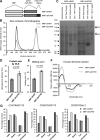A t(1;11) translocation linked to schizophrenia and affective disorders gives rise to aberrant chimeric DISC1 transcripts that encode structurally altered, deleterious mitochondrial proteins
- PMID: 22547224
- PMCID: PMC3392113
- DOI: 10.1093/hmg/dds169
A t(1;11) translocation linked to schizophrenia and affective disorders gives rise to aberrant chimeric DISC1 transcripts that encode structurally altered, deleterious mitochondrial proteins
Abstract
Disrupted-In-Schizophrenia 1 (DISC1) was identified as a risk factor for psychiatric illness through its disruption by a balanced chromosomal translocation, t(1;11)(q42.1;q14.3), that co-segregates with schizophrenia, bipolar disorder and depression. We previously reported that the translocation reduces DISC1 expression, consistent with a haploinsufficiency disease model. Here we report that, in lymphoblastoid cell lines, the translocation additionally results in the production of abnormal transcripts due to the fusion of DISC1 with a disrupted gene on chromosome 11 (DISC1FP1/Boymaw). These chimeric transcripts encode abnormal proteins, designated CP1, CP60 and CP69, consisting of DISC1 amino acids 1-597 plus 1, 60 or 69 amino acids, respectively. The novel 69 amino acids in CP69 induce increased α-helical content and formation of large stable protein assemblies. The same is predicted for CP60. Both CP60 and CP69 exhibit profoundly altered functional properties within cell lines and neurons. Both are predominantly targeted to mitochondria, where they induce clustering and loss of membrane potential, indicative of severe mitochondrial dysfunction. There is currently no access to neural material from translocation carriers to confirm these findings, but there is no reason to suppose that these chimeric transcripts will not also be expressed in the brain. There is thus potential for the production of abnormal chimeric proteins in the brains of translocation carriers, although at substantially lower levels than for native DISC1. The mechanism by which inheritance of the translocation increases risk of psychiatric illness may therefore involve both DISC1 haploinsufficiency and mitochondrial deficiency due to the effects of abnormal chimeric protein expression. GenBank accession numbers: DISC1FP1 (EU302123), Boymaw (GU134617), der 11 chimeric transcript DISC1FP1 exon 2 to DISC1 exon 9 (JQ650115), der 1 chimeric transcript DISC1 exon 4 to DISC1FP1 exon 4 (JQ650116), der 1 chimeric transcript DISC1 exon 6 to DISC1FP1 exon 3a (JQ650117).
Figures






References
-
- Blackwood D.H., Fordyce A., Walker M.T., St Clair D.M., Porteous D.J., Muir W.J. Schizophrenia and affective disorders—cosegregation with a translocation at chromosome 1q42 that directly disrupts brain-expressed genes: clinical and P300 findings in a family. Am. J. Hum. Genet. 2001;69:428–433. - PMC - PubMed
-
- Millar J.K., Wilson-Annan J.C., Anderson S., Christie S., Taylor M.S., Semple C.A., Devon R.S., St Clair D.M., Muir W.J., Blackwood D.H., et al. Disruption of two novel genes by a translocation co-segregating with schizophrenia. Hum. Mol. Genet. 2000;9:1415–1423. - PubMed
-
- Chubb J.E., Bradshaw N.J., Soares D.C., Porteous D.J., Millar J.K. The DISC locus in psychiatric illness. Mol. Psychiatry. 2008;13:36–64. - PubMed
Publication types
MeSH terms
Substances
Grants and funding
LinkOut - more resources
Full Text Sources
Other Literature Sources
Medical

